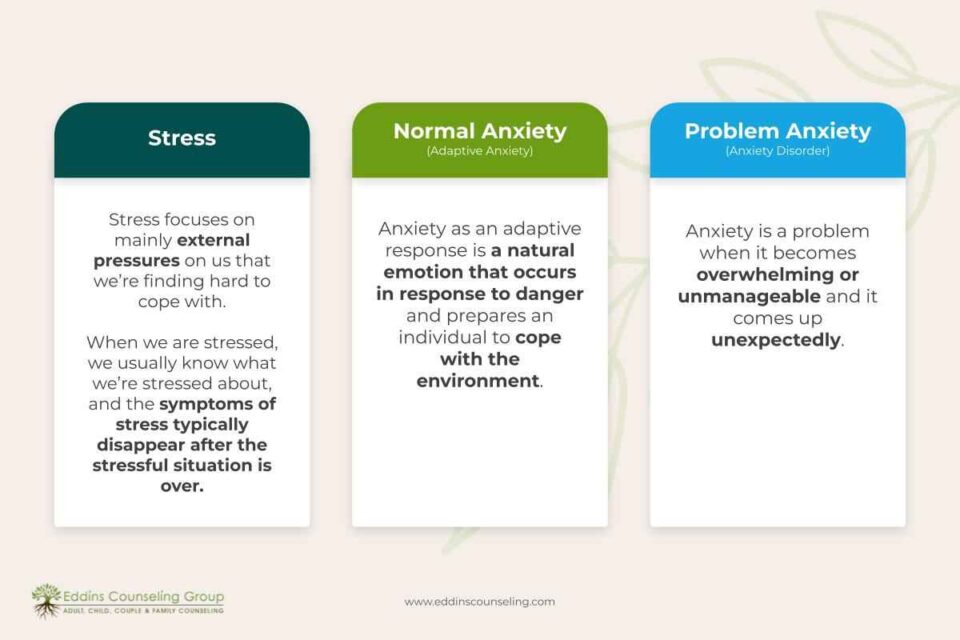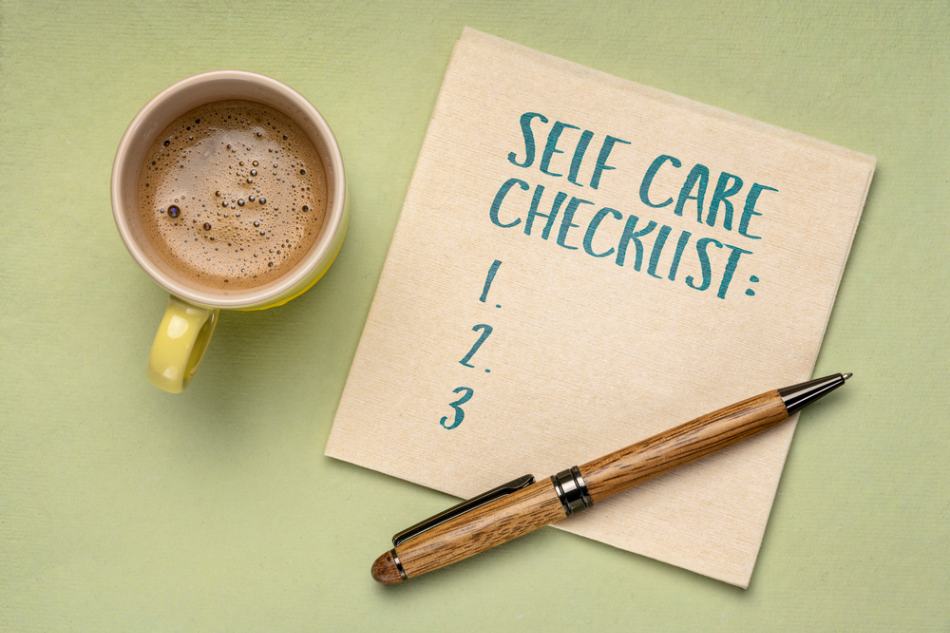January 12, 2023
Webinar: The Anxiety Cycle and How to Manage It
Written by Rachel Eddins

Anxiety is a real and challenging condition where our body, our mind, and our experiences get caught up in a cycle of increasing worries and physical symptoms.
The cycle can be turned around with knowledge, skills, and practice. Come learn how to break the pattern and develop tools to help manage anxiety.
This webinar is facilitated by Elizabeth Lowrey.
Watch a replay of the presentation here.
Learn more about anxiety and ways talking to a therapist can help with anxiety.
Here is a transcript of the webinar:
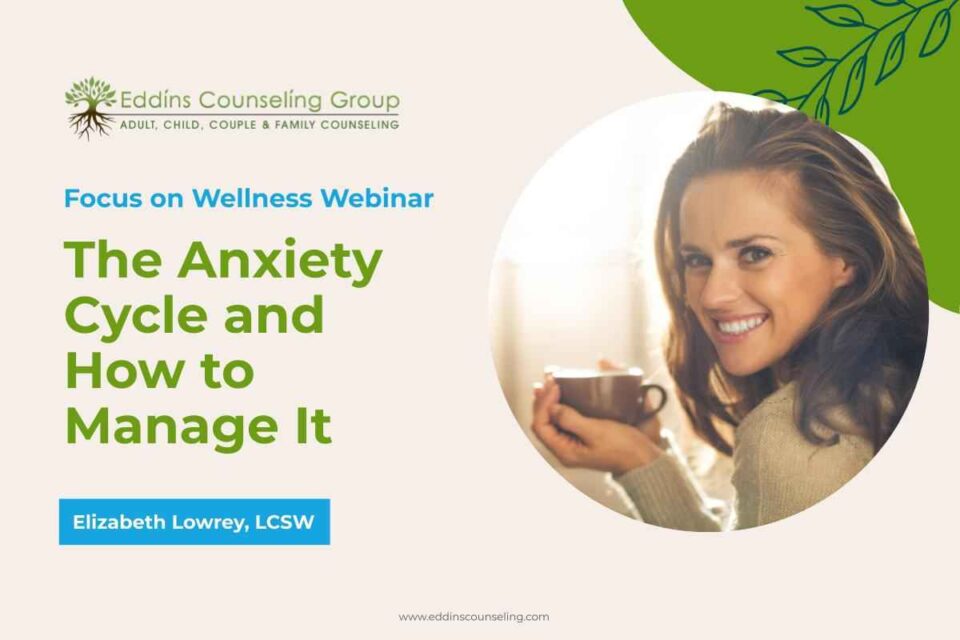
Welcome to the Eddins Counseling Focus on Wellness presentation on The Anxiety Cycle and How to Manage It. Our group offers free monthly webinar series on a variety of topics facilitated by our therapists.
My name is Elizabeth Lowrey, a therapist in our Montrose location. I’m a licensed clinical social worker. I’ve been working in the mental health field now for about seven years in a variety of roles. I’ve been with this group now for the last eight months.
My focus and my specialties are: I work with adult individuals that are seeking support for anxiety and depression, addiction, adjusting to chronic illness, burnout, grief, and loss.
Learning Objectives
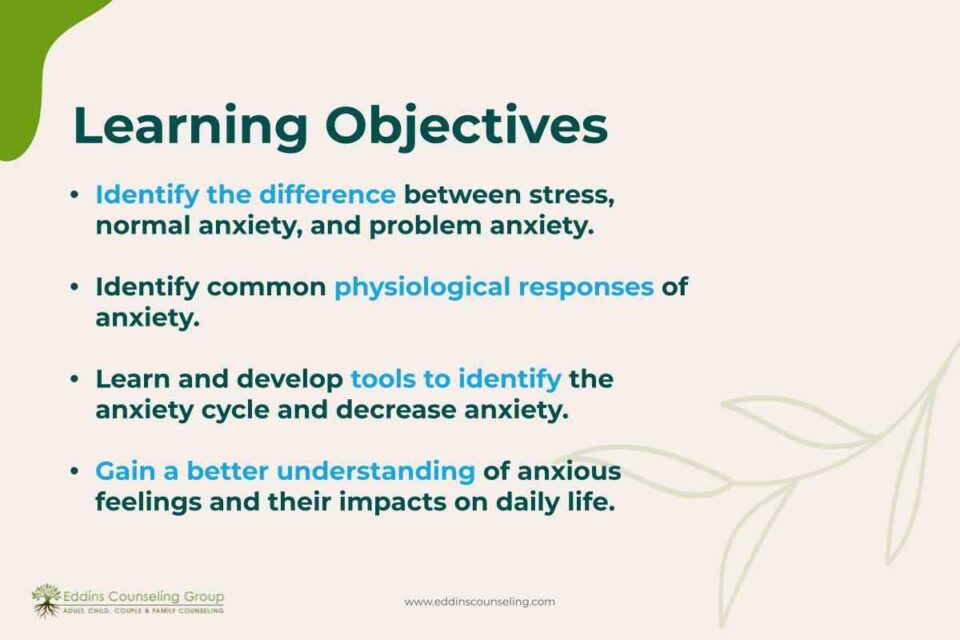
My goals for today and with this presentation are:
- Identify the difference between stress, normal anxiety, and problem anxiety
- Identify common physiological responses of anxiety
- Learn and develop tools to identify the anxiety cycle and decrease anxiety
- Gain a better understanding of anxious feelings and their impacts on daily life
What is Anxiety?
- An uncomfortable feeling of unease or fear
- Natural reaction to situations that are stressful or dangerous
- Designed to keep us safe from harm
- Everyone feels anxious at times, especially when facing challenging or unfamiliar situations or an important event
- If under control, feeling a little anxious can even help us be alert and focused a times
- Can become a problem when it happens too often, feels overwhelming, or goes on for too long
- Some people can find it hard to control their anxious thoughts which can start to affect their day-to-day life
Anxiety can be a very uncomfortable feeling of unease or fear that we experience.
It can be a very natural reaction to situations that are stressful or dangerous. So, for example, if we have something dangerous in our environment and we will have a very natural reaction to try and take care of ourselves.
Anxiety is designed to keep us safe from harm.
It’s very common for people to feel anxious from time to time, especially when you’re in an environment where you’re facing a challenge or something unfamiliar or there’s an important event that’s happening in your life.
When it’s under control, it can feel like some anxiety is actually helpful at the moment. However, it can become a problem.
So when it is happening pretty frequently, or when you’re feeling overwhelmed, or if it’s lasting for long periods of time, some people find it really hard to control these anxious thoughts and it starts to affect their day-to-day life.
Common Symptoms of Anxiety
- Shortness of breath
- Racing heart
- Sweating
- Dizziness and light-headed
- Restlessness
- Muscle tension
- Racing thoughts
- Obsessive thinking
- Sense of doom or dread
- Feeling out of control
- Feeling like you are going to die
Some signs that people could be experiencing anxiety are shortness of breath so they’re noticing their breath is like getting caught in their throat. Or, you have a racing heartbeat.
So really feeling like your heart is about to come out of your chest.
Sweating, dizziness, and light-headedness. Restlessness, where some people will start fidgeting with their hands or like shaking their knees, or any kind of body movement.
Another common symptom of anxiety is muscle tension. So a lot of us hold some stress in our shoulders and that can move into our neck and cause some tension headaches.
Racing thoughts and obsessive thinking, or a sense of doom or dread. Feeling out of control and sometimes that can lead to people feeling like they’re going to die.
So if you’re having that shortness of breath, racing heart, sweating, all of a sudden those signs really start triggering and you are thinking:
“Oh my gosh, something dangerous is happening or something bad is happening.” That’s kind of where that feeling of going to die might come from.
The Connection Between Stress and Anxiety
Stress and anxiety are very much connected and go together. So we have stress, normal anxiety or adaptive anxiety, and problem anxiety or anxiety disorder.
Stress
Stress is when we focus on mainly external pressure on us that we’re having a hard time coping with.
So, for example, a deadline at work, or having to get something done. When that stressor is over, typically all that stress from the situation disappears.
Normal Anxiety or Adaptive Anxiety
Normal anxiety or adaptive anxiety is a response to a natural motion that occurs in response to danger and prepares an individual to cope with their environment.
So, for example, there’s a bear in your environment and you need to react a certain way to make sure to get yourself out of danger.
Problem Anxiety or Anxiety Disorder
Problem anxiety is when anxiety becomes so overwhelming or unmanageable and it becomes unpredictable.
All of these are connected and we see people using them interchangeably.
But there is some anxiety that is adaptive and very normal to experience.
And then we have some anxiety that our brain basically gets rewired and it’s telling us we are in danger when there really is no danger in the environment.
Stress Response
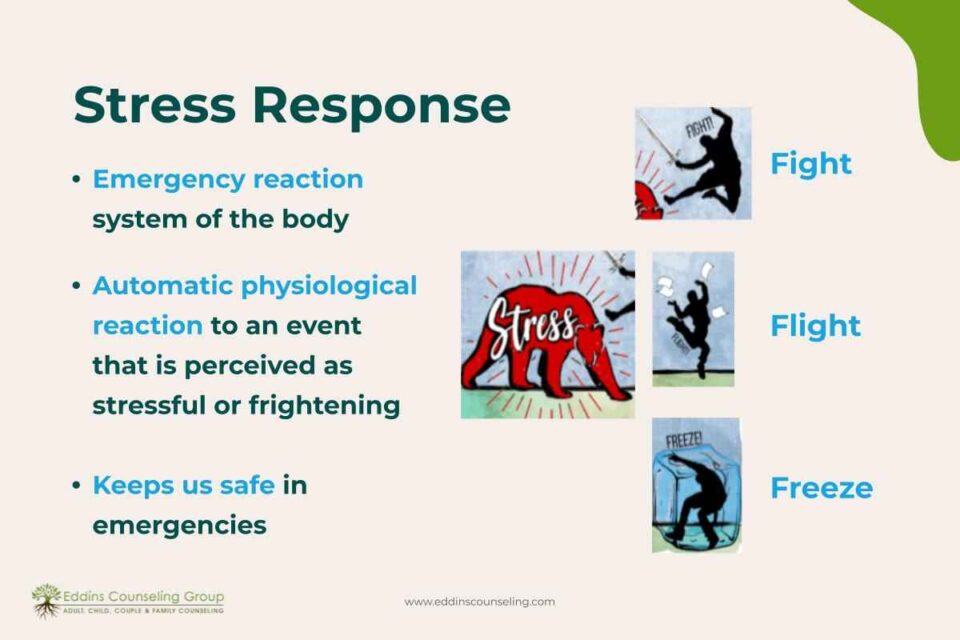
The stress response is an emergency reaction system in the body.
It’s an automatic physiological reaction to an event that is perceived as stressful or frightening and it’s there to keep us safe in emergencies. As we mentioned earlier, anxiety is there to keep us from harm.
An example of the stress response is the Fight/Flight/Freeze.
Our body is reacting to a stressor in our environment.
So if there is a bear in our environment, our body has an automatic reaction to try and keep us safe and cope with the environment we’re in. Our body is automatically reacting.
Either we’re fighting, we’re fleeing, or we’re freezing.
This stress response happens when you are experiencing normal anxiety and problem anxiety.
Normal Anxiety vs. Problem Anxiety
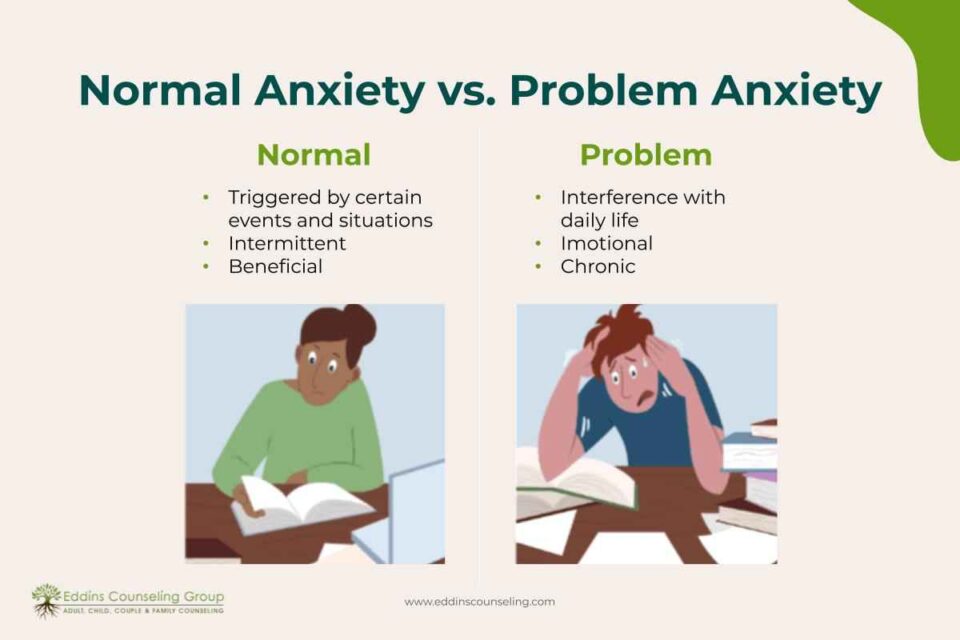
What is happening is that a stress response is being triggered which is a Fight/Flight/Freeze.
In normal anxiety:
- It is related to a specific situation or problem
- Lasts only as long as the situation or problem
- Is proportional to the situation or problem
- Is a realistic response to a realistic problem or situation
Normal anxiety is usually short-term and related to a stressor. It does not cause significant distress and is resolved in a short time.
It does cause distress, but it’s not extreme distress and it’s resolved in a short time period.
So when the stressor disappears, that distress decreases.
Stress produces anxiety that is adaptive when the individual is able to respond and alter themselves for the environment.
So in the example of “there is a bear in my environment”, your body has a stress response which is the Fight/Flight/Freeze. It is telling your body how to react to the environment.
When it becomes a problem or when it really starts impacting someone’s daily life, that stress response is still happening.
So the Fight/Flight/Freeze is happening, but there’s not an actual danger in the environment like a bear. For someone who could be experiencing this kind of anxiety, it may come up unexpectedly.
So they could have a trigger in their environment that tells their body they need to go into the stress response to protect themselves.
The response to the situation or problem may be much bigger than what’s expected. So you’re kind of thrown off by the reaction of your body.
- You may feel like you’re about to die.
- You’re having trouble breathing.
- Something’s wrong.
And you’re trying to figure out what in my environment is causing me to feel this way.
The person may experience a lot of unrealistic anxiety, such as a fear of a situation likely that will never happen. So almost kind of playing out a story that they start thinking about and it triggers that anxiety response.
When it lasts for a long period of time, even when the situation or problem has been resolved, the anxiety may feel impossible to control or manage. So feeling very overwhelmed by these feelings of anxiety.
It can often lead to having to avoid situations or things that are connected to these anxiety triggers.
The Vicious Cycle of Anxiety
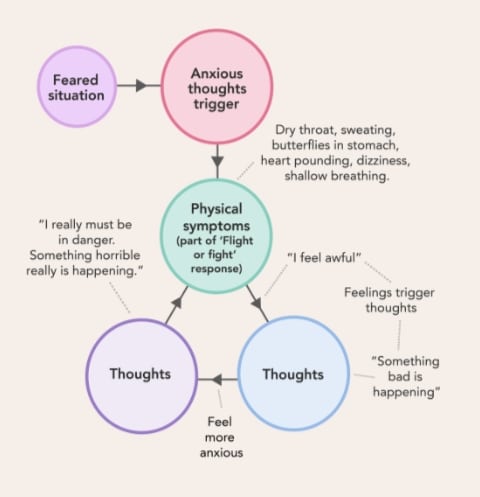
The Vicious Cycle of Anxiety is a cycle of thoughts and physical symptoms that can sometimes develop which can cause your anxiety to increase and keep going.
So that stress response is triggered and you can kind of get caught in a cycle of your anxiety increasing because you have a feared situation that now triggers anxious thoughts. And these thoughts are now triggering a stress response of flight or fight.
Your body is starting to react to that. So you can have some of these symptoms that we talked about earlier such as a dry throat, sweating, butterflies in your stomach, heart pounding, and shallow breath.
You are starting to notice that something is wrong if your body is reacting to that.
So now that triggers a new thought:
“Oh, man, I feel awful. What is going on? Something bad is happening.”
Now that triggers a new thought: “I really must be in danger. Something horrible is really happening.”
You can get kind of stuck in the cycle of anxious thoughts triggering a physical symptom that now triggers a new thought, and you can get stuck in this loop.
Once this cycle has developed, it’s very common for people to look for ways of reducing anxiety because it feels very uncomfortable and you want to make it stop.
If you’re going to the point of “I feel like I’m going to die”, you’re looking for ways to manage this feeling.
Safety behaviors are things that you might do to reduce anxiety and feel safer. Some people can also start avoiding or wanting to escape the situation.
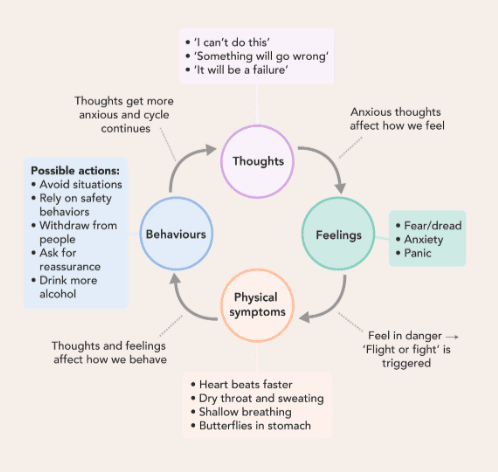
This diagram is similar to the diagram before in that it’s showing that thoughts, feelings, physical symptoms, and behaviors are all connected.
If we have thought: “I can’t do this. Something will go wrong. It will be a failure.”, it now triggers some feelings that are connected to those thoughts.
Those anxious thoughts now will trigger feelings of fear or dread, anxiety or panic.
You’re feeling those things, so your body’s stress response kicks in. So you have the fight or flight kicking in because you’re telling your body, something is dangerous in my environment.
Your body is getting ready to react to what is in your environment. You have the heart beating quickly, a dry throat and sweating, shallow breathing, and butterflies in the stomach. Now those symptoms are connected to behaviors that you might have.
Our thoughts and feelings affect how we behave.
Some possible reaction to this cycle is people will avoid situations. If I have a situation that I know triggers these anxious thoughts and feelings and symptoms, the way I can make myself not feel those things is to avoid it altogether.
Or rely on safety behaviors. So safety behavior is if someone is walking into a room and they feel like they need to know:
- “What are my exit strategies?”
- “How do I get out of here?”
- “I’m going to pick a seat close to the door, and I can look at the exit, so I know I can get out of here if there is an emergency.”
Some people will withdraw, others will ask for reassurance, and some people will use substances to kind of help numb those feelings of discomfort and distress.
Safety Behaviors and Avoidance
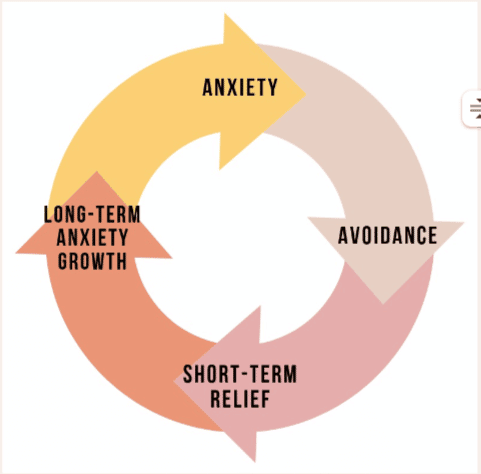
Safety behaviors and avoidance may reduce discomfort at the moment. This cycle of avoidance can lead to believing that you can’t do certain things without safety behaviors.
Avoidance
Avoidance is when we have an uncomfortable symptom of anxiety. It could be racing thoughts, heart beating, or any of those common symptoms of anxiety. We are trying to figure out how to control it and how to decrease it.
So, for example, someone gets nervous about giving presentations in class. A way to not have to feel those uncomfortable feelings is: “I’m going to skip class so I don’t have to give this presentation”.
Another avoidance coping mechanism is using certain substances. Alcohol and drugs can be a way to try and kind of dampen down those really uncomfortable feelings of anxiety.
Procrastinating is another way. There’s a whole procrastination cycle that happens.
That is mainly avoidance because there’s anxiety about a challenging task that you must complete.
And then what’s really common too is avoiding confrontation and relationships. There could be something going on in your relationship that you are finding unpleasant and you want to address it.
However, there’s this fear of how will that person react to it. So instead of having to deal with that reaction, you’re just going to avoid this confrontation.
Short-Term Relief
What happens in this cycle with avoidance is we get short-term relief. So we do get relief, which is nice.
However, it’s only temporary.
So it is immediate gratification but what usually happens is it will increase anxiety.
That relief is nice at the moment, but you have to continue avoiding a situation.
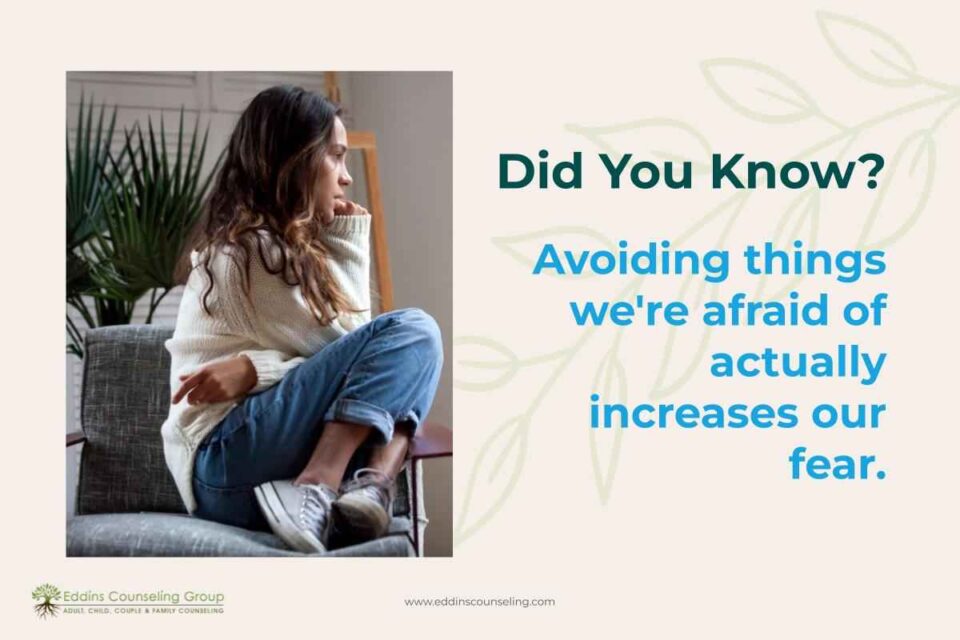
Long-Term Anxiety Growth
Avoiding situations that produce feelings of anxiousness actually INCREASES your anxiety in the long run. So short-term does give you some relief. However, in the long run, your anxiety will grow for those specific triggers.
Take the example of someone who struggles with public speaking and presentations. They continue to avoid presentations, and that anxiety will continue to build, basically giving more power to that trigger.
Avoidance of negative emotions associated with anxiety can cause a decrease in an individual’s ability to tolerate distress or risk.
So what that distress is, is those uncomfortable feelings that are coming up when you’re experiencing anxiety.
Those thoughts like: “I’m a failure, I’m going to get this wrong”, trigger those feelings of fear, panic, and adequacy and those are not fun things to feel.
If you continue to avoid your ability to try and tolerate those feelings and exploring those feelings and figuring out other coping mechanisms becomes harder.
This is because your brain learns avoidance is a really easy way to deal with it because you get this instant gratification and you kind of create a new wiring in your brain.
The fear that initially led to avoidance worsens and the brain learns that when an anxiety-provoking situation is avoided, symptoms go away.
And it’s not that all avoidance is bad, it’s just if that is your only coping mechanism, you will probably see your anxiety increase over these certain triggers.
Because at the end of the day, we are looking for ways we can cope, and ways we can have some relief. And avoidance does give us relief.
It’s just instant relief that doesn’t last long and can sometimes actually make the situation worse long-term.
Identifying the Cycle of Anxiety
One of the first steps in learning to cope with and heal from anxiety is identifying when this cycle is happening and how it’s impacting your day-to-day life.
Identify the various triggers of your anxiety
Understanding the anxiety cycle will help to identify various triggers of your anxiety.
- So with some of the examples of public speaking, that could be someone’s trigger.
- Or a trigger can be social events, so having like social anxiety and feeling really uncomfortable in new settings or meeting new people.
- Some people can have school anxiety.
- Others can have work anxiety.
The cycle helps you start identifying what things in your environment that are starting to trigger this problem anxiety where the stress response (the Fight/Flight/Freeze) is kicking in when there is no danger in your environment.
Recognize the unhealthy coping patterns you have developed in order to avoid feeling anxious
This cycle kind of helps you look at if you’re using avoidance and what other coping strategies are you using to try and cope with your anxiety.
Realize that avoiding the triggers to your anxiety may provide temporary relief
The next step is realizing that avoiding the triggers to your anxiety may provide temporary relief.
Remember short-term relief doesn’t lead to long-term growth
Remember that short-term relief doesn’t lead to long-term growth.
Yes, you are trying to figure out how to kind of get through these really challenging moments, but it is a temporary release and if you are wanting to make a change, figuring out what are those other coping mechanisms you can develop and practice for long-term growth and reduce your anxiety in these crisis situations.
Tools and Techniques to Manage Anxiety
- Mindfulness
- Cognitive Reframing
- Journaling and thought records
- Behavior Activation
- Exposure Therapy
- Behavioral Experiments
- Stress reduction techniques
- ABC Model (cognitive triangle)
- Distract, Relax, Cope
- Big List of Pleasurable activities
- Feelings Thermometer
There are a lot of different tools and therapy techniques out there. These are just a couple of them.
I’m going to talk about a couple of these. I have some worksheets that I bring into sessions with my clients that I will also go over with you all.
Mindfulness
The first one is Mindfulness.
Mindfulness is a state of active, open attention to the present. It is a practice that focuses on observing one’s thoughts and feelings without judging.
When you notice the anxiety cycle starting, you want to try and de-escalate yourself. So that stress response is triggered. You’re in the fight, flight, or freeze and your body is kind of in overdrive.
This mindfulness exercise is a way to try and de-escalate, slow yourself down, and kind of tell your body that you are okay and that you are safe.
Here are some exercises that I will use with clients and use myself if I notice a client is starting to become overwhelmed in a session (I usually will take a pause and try and incorporate one of these exercises).
- Five Senses Exercise (5-4-3-2-1)
- Body Scan
- Box breathing
- Guided meditation
All of these exercises are to pull yourself into the present because when you are experiencing anxiety, your mind is either in the past or the future.
The idea is: “How can I pull myself into the present, observe where I am, and kind of slow myself down?”
This is because that anxiety cycle really picks up quickly. So it’s all about trying to regulate yourself.
Since it is a practice, usually the first couple of times of trying these exercises, you’ll feel something, but it’s nothing compared to that instant relief you might get with avoiding.
The idea with practice and skill is that you’re consistent with it, that you try it when you’re not in a crisis state.
So kind of preparing for:
“When anxiety happens, I’ve done this when I have felt more regulated, so I know how to kind of walk myself through these exercises”.
The Five Senses Worksheet
The five senses exercise is this one:
I will have my client take a couple of deep breaths, kind of slow themselves down, and try and stop the thought train that they’re having that is triggering some anxious thoughts and feelings.
The first thing that I’ll do is I’ll ask them to point out five things that they can see in their environment. They have to start looking around and observing what is in the room. So they spend some time identifying those five things that they see in my therapy room.
Then I’ll ask them for four things that they can feel. Now they’ve slowed themselves down more because they’re in the present looking around their environment. They’re using their hands and usually touching and saying what are some things that they can feel in their environment.
I’ll ask for three things that you can hear, two things that you can smell, and one thing that you can taste.
I find that this exercise works in the therapy room, but there’s only so much going on in a small little therapy room.
It’s great when you’re out and about, and it’s a way to pull yourself into the present.
If you notice your thoughts are leading you to the future or to the past, and they’re triggering these anxious thoughts.
It’s a good way to kind of slow yourself down.
Cognitive Reframing
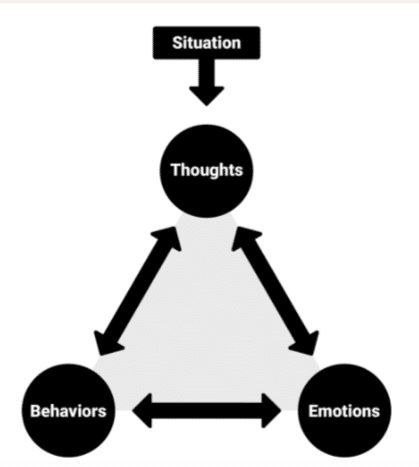
The next technique is cognitive reframing.
Our thoughts about our experiences drive our emotions, behaviors, and outcomes.
The idea behind this technique is that our negative thoughts can impact our emotions and behavior. Cognitive reframing is a process by which we challenge those negative thoughts that we are experiencing.
This diagram is the cognitive triangle, and it’s pretty similar to some of the cycle diagrams I showed earlier in this presentation.
What this diagram is showing is that we have a situation.
It could be an upsetting situation that you are experiencing that triggers a thought. Now that thought triggers an emotion, and that emotion triggers a behavior. That behavior triggers a new thought, and that thought trigger triggers more emotions.
It’s easy to get stuck in this triangle, especially if you’re noticing you’re having negative thoughts.
We had the mindfulness exercise first because that is an exercise that can help kind of slow you down, calm yourself down, be able to tell yourself:
“I’m safe. I am okay. There is not a bear in my environment. There is something in my environment that’s stressing me out, but my body is safe and I am safe.”
With cognitive reframing, it’s taking it to the next step of:
“I’ve tried to de-escalate myself a little bit. I’m trying to turn off that stress response of the Fight/Flight/Freeze, and I want to try and reframe some of the negative thoughts I’m having.”
This is hard to do when you are in a crisis and this is a new skill.
So this is also a practice and skill that takes some time and usually the first couple of times of doing this you don’t understand how to reframe a negative thought.
It’s important to try these exercises when you’re not in a crisis to build those skills for when a crisis does arise.
Cognitive Reframing and Mood Logs
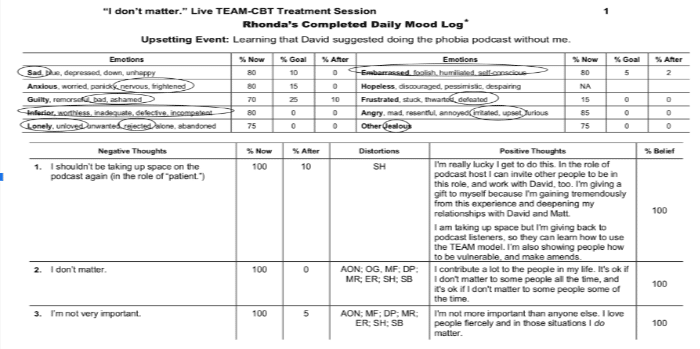
A way to work on this skill of reframing negative thoughts is by using a mood log. A mood log is basically like journaling your feelings and your thoughts that happen after an upsetting event.
So this is an example of a mood log.
1) The way you start this worksheet is you will write down what was the upsetting event that you experienced. The example here is learning that David suggested doing the phobia podcast without me. So this person who did their mood log found that this situation triggered a lot of emotions and negative thoughts that they had.
2) The next step of this worksheet is to identify all of the emotions that you feel in this upsetting event. This person was feeling sad, nervous, bad, ashamed, inferior, lonely, embarrassed, defeated, irritated, upset, and jealous. So a lot of different emotions at that moment.
It’s hard to identify what you’re feeling in a crisis. The idea behind this exercise is: “I’m going to try and do this after the event has happened, and I’m going to look back and try and identify what, what was I feeling in those moments.”
We see the emotions and next to it is a percentage. So then you’re rating how much did you feel this emotion from 0 to 100.
100% means you were very sad, or 100% you were very nervous. Rating it to see how much distress you were experiencing.
3) Then we move down to the next category, which is negative thoughts.
Here you’re going to write down every negative thought that was triggered by these emotions. This a helpful way to think about what were some of the negative thoughts you were having in this event. Because you might not remember all the particulars that happened in an upsetting event.
You can ask yourself:
“When I feel guilty, what am I thinking? When I’m feeling lonely, what are things that I might be thinking?”
It’s a way to kind of figure out what were some of those negative thoughts that were starting to trigger this anxiety for you.
The example this person put was: “I shouldn’t be taking up space on the podcast again.” In the next column, you rate how much you believe this statement. So this person believed it 100%.
4) Two columns over it say distortions. What this column is asking is for you to identify the cognitive distortion. A cognitive distortion is a thought process that impacts how we feel.
I have a list of cognitive distortions that I’ll review with you guys. It’s a specific thought process that impacts how we feel about ourselves or our situation.
With the mood log, you’re identifying the emotions. You’re trying to come up with what thoughts those emotions triggered and can you identify a cognitive distortion in this thought that’s telling me that you shouldn’t be taking up space?
5) Now, the next step is how you reframe it. This next part of the column is the positive thoughts. Trying to reframe this negative thought: “I shouldn’t be taking up space on the podcast.”
I don’t expect the first couple of times of doing this mood log that you do it perfectly. You would probably never do it perfectly because it is challenging to figure out how to reframe this to make it positive.
The idea is that you’re trying to look at the evidence in your environment to challenge that negative thought.
So the way this person reframed it: “I’m lucky I get to do this.”
“In the role of podcast host, I can invite other people to be in this role and work with David too.”, “I’m giving a gift to myself because I’m gaining tremendously from experience and deepening my relationship with David and Matt.”
So the idea is how do you challenge: “I shouldn’t be taking up space.” The way this person did that was: “I am the podcast host and I love that I get to run a podcast, connect with people, and decide to have other people on the podcast to host.”
6) The idea is now that you rate how much you believe this statement. Now that you have changed the negative thought and you’re going to go through every negative thought that you experience, kind of rating how much you believe it and trying to reframe it, and know how much you believe the reframing.
This is one kind of activity that you can do to start learning how to identify those emotions and see how those emotions impact your negative thoughts.
Cognitive Reframing and Challenging Automatic Negative Thoughts

Another worksheet that focuses on reframing negative thoughts is called Challenging Automatic Negative Thoughts. It’s similar to the mood log but looks a little less intimidating with all of the columns and all the things going on.
1) The first step is first recognizing and isolating thoughts. You’re having to kind of slow yourself down and tell yourself: “I’m okay”, take a deep breath, and then get in the headspace of: “What are some of the thoughts that I’m having at this moment?”
2) Write down your thought.
3) And then just rating your distress level. So these negative thoughts that you’re having on a level of zero to ten. So zero being calm, ten being like extreme anxiety, how distressing are these thoughts for me?
4) Then we identify the distortion type. So the cognitive distortion, that thought process that’s influencing how we think.
5) Then we have step five where you’re going to try and challenge and reframe this thought. So you’re trying to kind of pick up evidence in your environment to reframe that negative thought.
6) And then next step is to reevaluate/rate your distress again.
Now, if this is happening in real-time, you’re not usually doing this exercise and rating how distressed you are. This exercise is when you are not in crisis and you are practicing.
So when you are in crisis, you remind yourself that this is what you have been practicing for.
Think of it like being a professional athlete. They have a big event coming up.
They spend months and months getting ready for Wimbledon or the Olympics. They don’t just go into Wimbledon or the Olympics with no practice.
So it’s kind of putting this time in a less high stake situation to be prepared for those times when you feel like you’re stuck in that anxiety cycle.
15 Cognitive Distortions
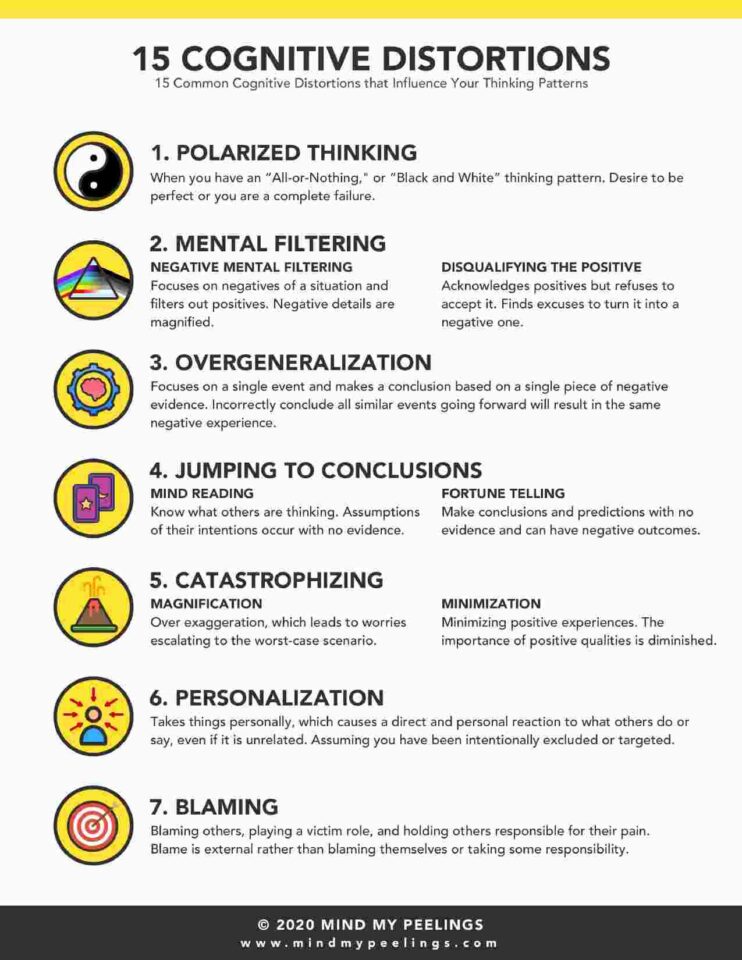
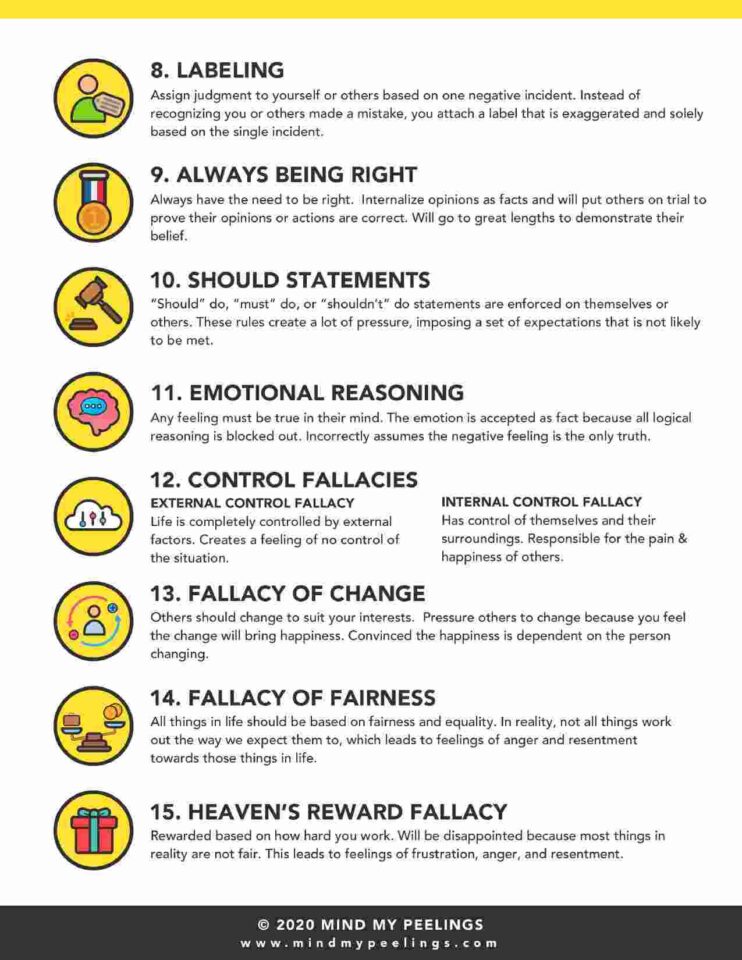
These are the cognitive distortions that I’ve been talking about. These thought processes that impact how we think about ourselves and the environment that we’re in. These are just 15 common cognitive distortions. I believe there are more, but these are the ones that we see the most.
Cognitive Distortions That I See Most Frequently
As a therapist who works with a lot of individuals that are dealing with anxiety, there are a couple of cognitive distortions that I see most frequently with my clients.
-
Polarized Thinking
Polarized thinking is all-or-nothing thinking. Basically, an example is when you’re on a diet and you make a mistake on your diet. So you make one mistake, your mind tells you: “I’ve already made a mistake, so who cares about the diet? I’m going to go on a binge.” The way to reframe that cognitive distortion with your diet is: “I’m human, I made one mistake, doesn’t mean that I ruined my diet.” That’s kind of one example of all-or-nothing thinking.
-
Jumping to Conclusions
Another one that I see quite frequently is jumping to conclusions. We have mind reading and fortune telling. With mind reading, that is when you assume you know what someone is thinking. A lot of times I’ll hear: “They probably think this about me, or this is what’s going on.” Jumping to the conclusion that you know what someone is thinking about you.
-
Catastrophizing
Then with catastrophizing, we have magnification and minimization. An example would be a spouse, a partner, or a friend that comes and tells you their doctor ordered them to get an X-ray or an MRI. Your brain goes straight to: “They have a tumor, they’re dying”. That is a cognitive distortion that’s impacting how you think about a situation.
Minimization would be the opposite of basically trying to push and be in denial and trying to not take in the environmental information that’s telling you that this is actually a big deal.
-
“Should” Statements
Another one I hear quite frequently is “should” statements. So I should do this, I should do that, which starts making you feel inadequate about yourself. I usually will call it “shooting on yourself.”
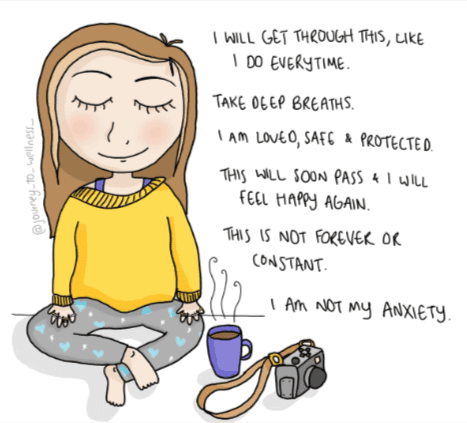
These tools and techniques take time to learn and feel kind of uncomfortable in the beginning. It’s all about kind of being consistent and practicing it in an environment where you feel safe and are not in crisis.
At the end of the day, remind yourself that you’re not your anxiety and that you are safe, and you are capable of managing these feelings.
Educational Resources
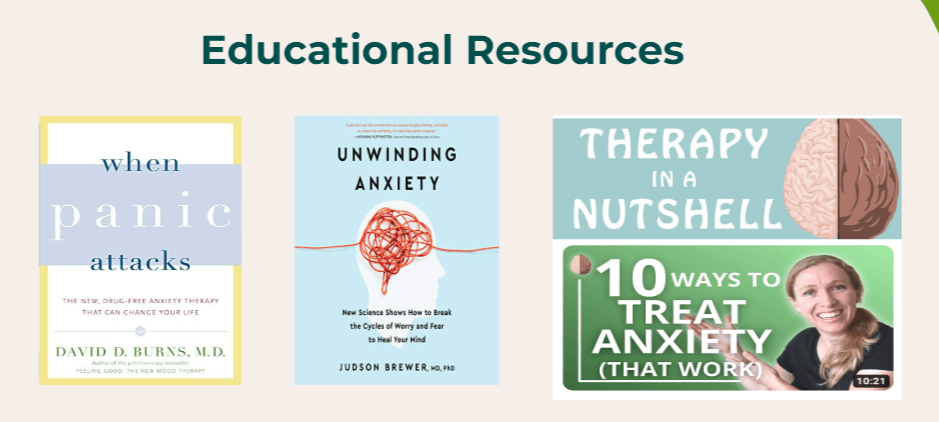
Here are some educational resources that I will recommend to my clients:
There’s a book called “When Panic Attacks” by Dr. David Burns. In his book, we can find the mood logs that we talked about earlier. Another book that is educational and helpful in kind of learning the anxiety cycle and how it impacts your mind is “Unwinding Anxiety.”
Another helpful resource is a YouTube channel that I will recommend to clients as well. It’s called “Therapy in a Nutshell”. It’s been created by a licensed professional counselor, and she creates videos that are 5-30 minutes long about different mental health topics.
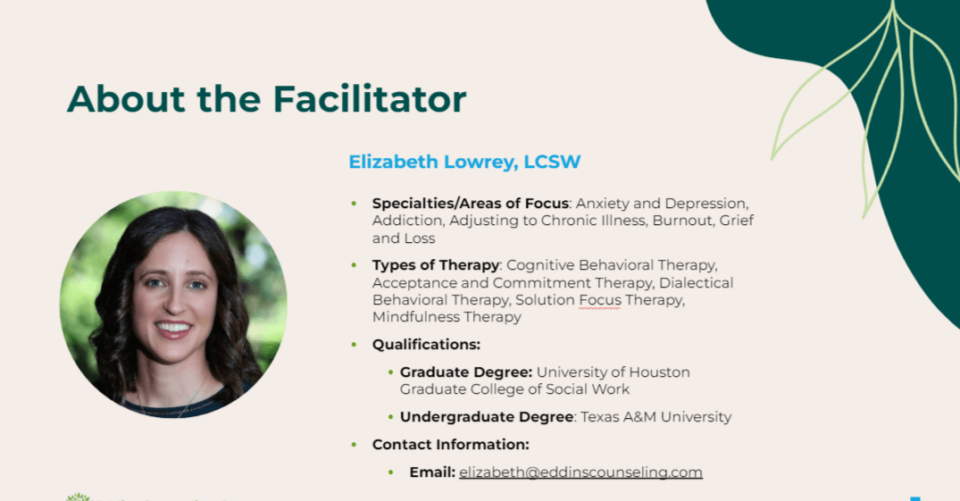
Here is my information. My name is Elizabeth. I’m a licensed clinical social worker. I’ve included my email address ([email protected]) if you have any questions or would like any of these worksheets.
Here at Eddins, we have a team of trained anxiety therapists. If you are interested in getting started, this is our main phone number:
Call (832) 559-2622 or Text (832) 699-5001
Thank you for joining and I hope you guys have a good evening.
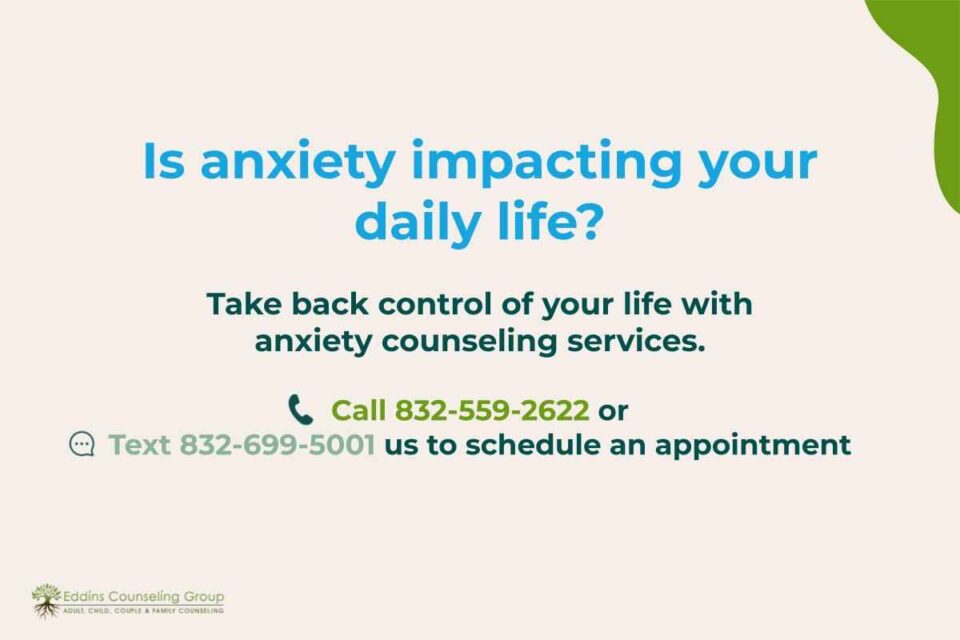
5 Ways to Reduce Anxiety
Get instant access to your free ebook.
Grounding & Self Soothing
Get instant access to your free ebook.
Create Healthier Thoughts & Feelings
Get instant access to your free ebook.
Why You Feel This Way
Get instant access to your free ebook.

